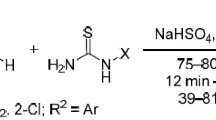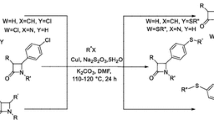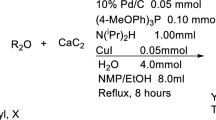Abstract
A simple, mild and convenient method has been developed for the synthesis of 3,4,5-trialkyl-1,3-thiazole-2(3H)-thione derivatives through one pot three-component reaction between a primary amine, carbon disulphide, and α-haloketone in the presence of potassium iodide at room temperature conditions. The products were obtained with excellent yield and appropriate reaction times. This reaction represents a rapid and unprecedented route to the described molecules that have biological specifications.

One-pot three-component reaction of primary amines, carbon disulphide and α-haloketone catalysed by potassium iodide (KI) via a simple, fast, mild and efficient method is reported.
Similar content being viewed by others
Explore related subjects
Discover the latest articles, news and stories from top researchers in related subjects.Avoid common mistakes on your manuscript.
1 Introduction
Multicomponent reactions (MCR) have appeared as an efficient and powerful tool in modern synthetic organic chemistry due to their valued features such as atom economy, straightforward reaction design, and the opportunity to construct target compounds by the introduction of several diversity elements in a single chemical event. Since all the organic reagents employed are consumed and incorporated into the target compound, purification of products resulting from MCR is also simple.[1] MCR, leading to interesting heterocyclic scaffolds, are especially useful for the construction of diverse chemical libraries of ‘druglike’ molecules. The isocyanide-based MCRs are very important in this area.[2–4] Among the known multicomponent reactions to date, the most valuable reactions are those based on isocyanides. Isocyanide-based multicomponent reactions (abbreviated to IMCRs by Ugi and Dömling) by virtue of their synthetic potential, their inherent atom efficiency, convergent nature, ease of implementation, and the generation of molecular diversity, have attracted considerable attention because of the advantages that they offer to the field of combinatorial chemistry.[5–9]
Organic compounds containing five-membered aromatic heterocyclic rings constitute a wide range of compounds in the nature and often play an important role in various biochemical processes. As a result, aromatic heterocycles such as thiophenes, benzothiophene derivatives, and their reduced forms are significant structural fragments in many pharmaceutical and chemical compounds. Thiazoline and thiazole compounds have been found to represent nematocidal, insecticidal, antibacterial, antifungal, antiviral, and antioxidant activity.[10–15] Tetrahydrothiophene is an important building block of a large quantity of compounds that are very interesting from the viewpoint of biological activity. Its derivatives have showed antisecretory and antiulcer activities.[16] Because of the potential use of thiophenes and annulated thiophenes as pharmaceuticals, conjugated polymers, organic conductors, semiconductors and light emitting devices, their synthesis are of special interest.[17–22] Alkylation of an intermediate dimetaloketene dithioacetal is a general strategy employed for the synthesis of alkylthiothiophenes or thienothiophenes.[23–26] As part of our ongoing program to develop efficient and robust methods for the preparation of heterocyclic compounds,[27–39] we have prepared 3-alkyl-4-phenyl-1,3-thiazole-2(3H)-thionewithout catalyst in our last report[40] and now we wish to report the preparation of a 3, 4, 5- trialkyl-1, 3- thiazole- 2 (3H)- thione derivatives through a one-pot multicomponent condensation reaction (MCR) in the presence of potassium iodide (scheme 1).
2 Experimental
Starting materials and solvents were obtained from Merck (Germany) and Fluka (Switzerland) and were used without further purification. TLC and NMR spectroscopy were used to follow the reactions. Melting points were measured on an Electrothermal 9100 apparatus and are uncorrected. IR spectra were measured on a Jasco 6300 FTIR spectrometer. 1H and 13C NMR spectra were measured (CDCl3 solution) with a BRUKER DRX-250 Avance spectrometer at 250.0 and 62.5 MHz, respectively. Elemental analyses were performed using a Heraeus CHN-O-Rapid analyzer. Preparative layer chromatography (PLC) plates were prepared from Merck silica gel (F254) powder.
2.1 General procedure for the preparation of compounds 4
The mixture of α-haloketone 1 (1 mmol) and potassium iodide 0.1 g (0.6 mmol) in CH3OH (7 ml) was stirred for 30 min and then the solution of primary amine (1 mmol) and carbon disulphide (1 mmol) was added, and the mixture was stirred for 24 h. The solvent was removed under reduced pressure and the viscous residue was purified by preparative layer chromatography (PLC) [silica gel (F254) powder; petroleum ether–ethyl acetate (10:2)]. The solvent was removed under reduced pressure and the products were obtained. The characterization data of the compounds are given below.
2.1a 3- (2- Furylmethyl)- 4,5- diphenyl- 1,3- thiazole-2(3H)- thione (4a): White powder, (yield: 85 %). IR (neat): \(\emph{v} = 3150\), 3000, 1625, 1600, 1475, 1300, 1100 cm − 1. 1H NMR (250 MHz, CDCl3) δ (ppm): 5.34 (s, 2H, CH2), 6.12 (s, 1H, CH of furan), 6.24 (s, 1H, CH of furan), 7.00–7.47 (m, 11H, CH\(_{\text{arom}}\) and CH of furan). 13CNMR (62.5 MHz, CDCl3) δ (ppm): 44.66 (CH2), 109.59, 110.47 (CH of furan), 125.00 (C of alkene), 128.02, 128.23, 128.64, 129.10, 130.00, 130.87 (10CH), 130.05, 130.19 (C), 138.63 (C of alkene), 142.04 (CH of furan), 147.94 (C of furan), 186.80 (C=S). MS, m/z (%): 349 (80), 316 (48), 210 (52), 171 (80), 151 (86), 105 (84), 81 (100), 69 (40), 53 (48). Analysis of C20H15NOS2 (349.47). (% calculation/found): C: 68.74/68.80, H: 4.33/4.39, N: 4.01/3.95.
2.1b 3- Benzyl- 4- (4- methoxyphenyl)- 1,3- thiazole-2(3H)- thione (4b): White powder, (yield: 87 %). IR (neat): \(\emph{v} \!=\! 3150\), 3000, 1625, 1600, 1475, 1300, 1100 cm − 1. 1H NMR (250 MHz, CDCl3) δ (ppm): 3.82 (s, 3H, OCH3), 5.39 (s, 2H, CH2), 6.45 (s, 1H, CH of alkene), 6.82–7.21 (m, 9H, CH\(_{\text{arom}}\)). 13CNMR (62.5 MHz, CDCl3) δ (ppm): 50.82 (CH2), 55.40 (OCH3), 108.65 (CH of alkene), 114.01, 126.98, 127.52, 128.49, 130.89 (9CH), 122. 79, 135.42, 160.67 (3C), 144.75 (C of alkene), 188.86 (C=S). MS, m/z (%): 313 (56), 297 (80), 280 (36), 229 (44), 206 (72), 149 (44), 135 (64), 91 (92), 69 (100), 57 (56). Analysis of C17H15NOS2 (313.44). (% calculation/found): C: 65.14/65.08, H: 4.82/4.88, N: 4.47/4.41.
2.1c 4- (4- Methoxyphenyl)- 3-(4- methylbenzyl)- 1,3- thiazole-2(3H)- thione (4c): White powder, (yield: 90 %). IR (neat): \(\emph{v} = 3100\), 3000, 1650, 1600, 1475, 1200 cm − 1. 1H NMR (250 MHz, CDCl3) δ (ppm): 2.29 (s, 3H, CH3), 3.82 (s, 3H, OCH3), 4.82 (s, 2H, CH2), 5.94 (s, 1H, CH of alkene), 6.84–7.26 (m, 8H, CH arom). 13CNMR (62.5 MHz, CDCl3) δ (ppm): 21.10 (CH3), 46.95 (CH2), 55.36 (OCH3), 98.28 (CH of alkene), 113.94, 127.07, 129.19, 130.53 (8CH), 123.77, 133.59, 137.09, 160.29 (4C), 137.61 (C of alkene), 172.85 (C=S). Analysis of C18H17NOS2 (327.46). (% calculation/found): C: 66.02/66.06, H: 5.23/5.17, N: 4.28/4.22.
2.1d 3- (2- Furylmethyl)- 4- (4- methoxyphenyl)- 1, 3- thiazole- 2(3H)- thione (4d): White powder, (yield: 94 %). IR (neat): \(\emph{v} =\) 3150, 3000, 1625, 1600, 1475, 1300, 1100 cm − 1. 1H NMR (250 MHz, CDCl3) δ (ppm): 3.85 (s, 3H, OCH3), 4.80 (s, 2H, CH2), 5.95 (s, 1H, CH of alkene), 6.03, 6.24 (s, 2CH, CH of furan), 6.92–7.29 (m, 5H, CH\(_{\text{arom}}\) and CH of furan). 13CNMR (62.5 MHz, CDCl3) δ (ppm): 40.48 (CH2), 55.38 (OCH3), 98.32, (CH of alkene), 108.60, 110.44, 142.21 (3CH of furan), 114.04, 130.61 (4CH), 123.50, 160.37 (2C), 137.22 (C of alkene), 149.36 (C of furan), 172.55 (C=S). Analysis of C15H13NO2S2 (303.40). (% calculation/found): C: 59.38/59.32, H: 4.32/4.26, N: 4.62/4.56.
2.1e 3-(2- Methoxybenzyl)-4-(4- methoxyphenyl)- 1, 3-thiazole- 2(3H)-thione (4e): White powder, (yield: 87 %). IR (neat): \(\emph{v} = 3100\), 3000, 1600, 1475, 1200 cm − 1. 1H NMR (250 MHz, CDCl3) δ (ppm): 3.67, 3.79 (2s, 6H, 2OCH3), 4.87 (s, 2H, CH2), 5.99 (s, 1H, CH of alkene), 6.74–7.22 (m, 8H, CH arom). 13CNMR (62.5 MHz, CDCl3) δ (ppm): 42.72 (CH2), 55.12, 55.31 (2OCH3), 98.07 (CH of alkene), 109.94, 113.85, 120.55, 126.78, 128.30, 130.08 (8CH), 123.81, 124.64, 156.31, 160.14 (4C), 137.99 (C of alkene), 172.79 (C=S). Analysis of C18H17NO2S2 (343.46). (% calculation/found): C: 62.94/62.88, H: 4.99/4.93, N: 4.08/4.02.
2.1f 3- (2- Methoxybenzyl)- 4-methyl-1, 3-thiazole- 2(3H)-thione (4f): White powder, (yield: 88%). IR (neat): \(\emph{v} = 3100\), 3000, 1600, 1475, 1200 cm − 1. 1H NMR (250 MHz, CDCl3) δ (ppm): 2.01(s, 3H, CH3), 3.86 (s, 3H, OCH3), 4.95 (s, 2H, CH2), 5.78 (s, 1H, CH of alkene), 6.85–6.90 (m, 4H, CH\(_{\text{arom}}\)). 13CNMR (62.5 MHz, CDCl3) δ (ppm): 15.12(CH3), 41.21 (CH2), 55.24(OCH3), 97.48 (CH of alkene), 110.11, 120.79, 126.61, 128.55 (4CH), 126.50, 158.61 (2C), 134.46 (C of alkene), 185.52 (C=S). Analysis of C12H13NOS2 (251.37). (% calculation/found): C: 57.34/57.40, H: 5.21/5.15, N: 5.57/5.51.
2.1g 3-(2-Methoxybenzyl)-4, 5-dimethyl-1, 3- thiazole- 2(3H)-thione (4g): White powder, (yield: 90 %). IR (neat): \(\emph{v} = 3100\), 3000, 1600, 1475, 1200 cm − 1. 1H NMR (250 MHz, CDCl3) δ (ppm): 1.90, 2.09 (2s, 6H, 2CH3), 3.85 (s, 3H, OCH3), 4.91 (s, 2H, CH2), 6.79–7.21 (m, 4H, CH\(_{\text{arom}}\)). 13CNMR (62.5 MHz, CDCl3) δ (ppm): 11.22 (CH3), 12.12 (CH3), 41.44 (CH2), 55.29 (OCH3), 108.28 (C of alkene), 110.06, 120.78, 126.61, 128.40 (4CH), 124.50, 158.61 (C), 142.46 (C of alkene), 171.92 (C=S). Analysis of C13H15NOS2 (265.39). (% calculation/found): C: 58.83/58.77, H: 5.70/5.76, N: 5.28/5.22.
2.1h 3-(2-Furylmethyl)-4, 5-dimethyl-1, 3-thiazole- 2(3H)-thione (4h): White powder, (yield: 92 %). IR (neat): \(\emph{v} = 3100\), 3000, 1600, 1475, 1200 cm − 1. 1H NMR (250 MHz, CDCl3) δ (ppm): 2.12, 2.28 (2s, 6H, 2CH3), 5.40 (s, 2H, CH2), 6.32, 6.47, 7.33 (3CH of furan). 13CNMR (62.5 MHz, CDCl3) δ (ppm): 11.63 (CH3), 12.78 (CH3), 43.75 (CH2), 110.05, 110.74, 142.30 (3CH of furan), 117.32, 134.52 (2C of alkene), 148.17 (C of furan), 186.92 (C=S). Analysis of C10H11NOS2 (225.33). (% calculation/found): C: 53.30/53.36, H: 4.92/4.98, N: 6.22/6.28.
2.1i 4,5 -Dimethyl-3-(4- methylbenzyl)-1,3- thiazole-2(3H)-thione (4i): White powder, (yield: 90 %). IR (neat): \(\emph{v} = 3100\), 3000, 1600, 1475, 1200 cm − 1. 1H NMR (250 MHz, CDCl3) δ (ppm): 2.04, 2.12, 2.31 (s, 9H, 3CH3), 5.47 (s, 2H, CH2), 7.11 (s, 4H, CH\(_{\text{arom}}\)). 13CNMR (62.5 MHz, CDCl3) δ (ppm): 11.58, 12.87, 21.00 (3CH3), 50.53 (CH2), 95.28 (C of alkene), 126.66, 129.45 (4CH), 132.04, 137.00 (2C), 138.46 (C of alkene), 171.92 (C=S). Analysis of C13H15NS2 (249.39). (% calculation/found): C: 62.61/62.55, H: 6.06/6.00, N: 5.62/5.68.
3 Results and discussions
We examined the reaction of primary amines, carbon disulphide with α-haloketone in the presence of potassium iodide in dry CH3OH at room temperature (25 °C) and we obtained the corresponding 3,4,5-trialkyl-1,3-thiazole-2(3H)-thione derivatives 4 in excellent yields. The reaction proceeds smoothly and cleanly under mild and neutral conditions, also no side products were observed. The compounds 4 were stable when stored at room temperature for several months.
The structures of products were deduced from their 1H NMR, 13C NMR, IR, and mass spectra. The mass spectra of these compounds displayed molecular ion peaks at the appropriate m/z values. The 1HNMR spectrum of 4a consisted of a singlet for CH2 at δ = 5.34 ppm, two singlet for 2CH of furan at δ = 6.12 and 6.24 ppm, and a multiplet at δ = 7.00–7.47 ppm for eleven aromatic protons and furan proton. The 1H decoupled 13C NMR spectrum of 4a showed 16 distinct resonances, partial assignment of these resonances is given in section 2. The 1H and 13C NMR spectra of compounds 4b–i were similar to those of 4a, except for the aromatic moiety, which exhibited characteristic signals with appropriate chemical shifts.
A possible mechanism for the present reaction is shown in scheme 2, which envisages a tandem sequence. On the basis of the established chemistry of trivalent nitrogen nucleophiles, the successful nucleophilic attack by amines on a carbon atom is facilitated when the latter is conjugated with a carbonyl group, or when it is a part of an otherwise activated unsaturated bond. First, the nucleophilic addition of the primary amine 3 to carbon disulphide 2 generates the nucleophilic carbamodithioic acid 5.[26] The next step involves nucleophilic attack of carbamodithioic acid 5 at the carbon of haloketone 1, leading to intermediate 6, and then ring closure by intramolecular attack of nitrogen at the carbonyl carbon to afford the 3,4,5- trialkyl-1,3-thiazole-2(3H)-thione derivatives 4.
Potassium iodide was found to catalyse the synthesis of 3,4,5-trialkyl-1,3-thiazole-2(3H)-thione derivatives 4 from α-haloketone 1, the primary amines 2, and carbondisulphide 3, in methanol (table 1). The use of just 0.1 g of potassium iodide (per mmol of reactants) is sufficient to push the reaction forward. Higher and lower amounts of potassium iodide (KI) did not considerably improve the yields (table 2). We also used other solvents in the presence of potassium iodide, but in all cases, increasing reaction times and decreasing yields of 4 were observed (table 3).
4 Conclusion
In this research work, a simple, mild and efficient method has been reported for preparation of 3,4,5-trialkyl-1,3-thiazole-2(3H)-thione derivatives. The products obtained in excellent yields under mild reaction and with simple work-up conditions. The products have been confirmed by physical and spectroscopic data such as; IR, 1HNMR, 13CNMR, MS spectroscopy, and CHN elemental analyses.
References
Zhu J and Bienaymé H (eds) 2005 Multicomponent reactions, Wiley-VCH, Weinheim.
Ugi I, Werner B and Dömling A 2003 Molecules 8 53
Domling A 2006 Chem. Rev. 106 17
Dömling A and Ugi I 2000 Angew. Chem. Int. Ed. 39 3168
Dömling A, Herdtweck E and Heck S 2006 Tetrahedron Lett. 47 1745
Ramazani A, Ahmadi Y and Tarasi R 2011 Heteroat. Chem. 22 79
Ramazani A, Zeinali Nasrabadi F, Mashhadi Malekzadeh A and Ahmadi Y 2011 Monatsh Chem. 142 625
Ramazani A, Farshadi A, Mahyari A, Ňlepokura K, Lis T and Rouhani M 2011 J. Chem. Crystallogr. 41 1376
Ramazani A, Karimi Z, Souldozi A and Ahmadi Y 2012 Turk. J. Chem. 36 81
Pessoa-Mahana H, Johann K.C, Nadia R.H, Recabarren-Gajardo G, Claudio S. B, Araya-Matsurana R and Pessoa-Mahana C.D 2008 Heterocycles 75 1913
Blagg J, Mowbray C, Pryde D.C, Salmon G, Schmid E, Fairman D and Beaumont K 2008 Bioorg. Med. Chem. Lett. 18 5601
Simoni D, Romagnoli R, Baruchello R, Rondanin R, Grisolia G, Eleopra M, Rizzi M, Tolomeo M, Giannini G, Alloatti D, Castorina M, Marcellini M and Pisano C 2008 J. Med. Chem. 51 6211
Radwan M A A, Shehab M A and El-Shenawy S M 2009 Monatsh. Chem. 140 445
Fakar I M I, Radwan M A A, El-Batran S, Abd El-Salam O M E and El-Shenawy S M 2009 Eur. J. Med. Chem. 44 1718
Abreu R M V, Ferreira I C F R and Queiroz M J R P 2009 Eur. J. Med. Chem. 44 1952
Aloup J C, Bouchaudon J, Farge D, James C, Deregnaucourt J and Hardy-Houis M 1987 J. Med. Chem. 30 24
Gronowitz S 1985 Thiophenes and its derivatives; S Gronowitz Ed, New York: John Wiley and Sons, Part 1 42
Luker T J, Beaton H G, Whiting M, Kete A and Cheshire D. R 2000 Tetrahedron Lett. 41 7731
Roncali J 1997 Chem. Rev. 97 173
Schopf G, Kossemehl G 1997 Adv. Polym. Sci. 129 1
Dimitrakopoulos C D and Malenfant P R L 2002 Adv. Mater. 14 99
Morrison J J, Murray M M, Li X C, Holmes A B, Morratti S C, Friend R H and Sirringhaus H 1999 Synth. Met. 102 987
Mashraqui S H, Hariharasubrahmanian H and Kumar S 1999 Synthesis 2030
Prim D, Joseph D and Kirsch G Liebigs 1996 Ann. Chem. 239
Augustine M, Rudorf W D and Schimdt U 1976 Tetrahedron 32 3055
Khalilzadeh M A, Hossaini Z, Baradarani M M and Hasannia A 2010 Tetrahedron 66 8464
Ramazani A, Ahmadi Y, Rouhani M., Shajari N and Souldozi A 2010 Heteroatom Chem. 21 368
Ramazani A, Shajari, N, Mahyari A and Ahmadi Y 2011 Mol. Divers. 15 521
Souldozi A and Ramazani A 2009 Phosphorus Sulfur Silicon 184 3191
Ramazani A and Souldozi A 2009 Phosphorus Sulfur Silicon 184 2344
Ramazani A, Zeinali Nasrabadi F, Karimi Z and Rouhani M 2011 Bull. Korean Chem. Soc. 32 2700
Ramazani A, Zeinali Nasrabadi F and Ahmadi Y 2011 Helv. Chim. Acta. 94 1024
Souldozi A, Ramazani A, Bouslimani N and Welter R 2007 Tetrahedron Lett. 48 2617
Souldozi A and Ramazani A 2007 Tetrahedron Lett. 48 1549
Ramazani A, Mahyari A T, Rouhani M and Rezaei A 2009 Tetrahedron Lett. 50 5625
Zeinali Nasrabadi F, Ramazani A and Ahmadi Y 2011 Mol. Divers. 15 791
Ramazani A, Ahmadi Y and Zeinali Nasrabadi F 2011 Z Naturforsch. 66b 184
Ramazani A and Souldozi A 2009 Phosphorus Sulfur Silicon Relat. Elem. 184 3191
Ramazani A and Rezaei A 2010 Org. Lett. 12 2852
Safaei-Ghomi J, Salimia F, Ramazani A, Zeinali Nasrabadi F and Ahmadi Y 2012 J. Sulfur Chem. 33 87
Acknowledgements
Authors are thankful to the University of Kashan for supporting this work (by Grant NO: 159196/VII).
Author information
Authors and Affiliations
Corresponding author
Additional information
Supplementary information
The electronic supporting information can be seen in www.ias.ac.in/chemsci.
Electronic Supplementary Material
Below is the link to the electronic supplementary material.
Rights and permissions
About this article
Cite this article
SAFAEI-GHOMI, J., SALIMI, F. & RAMAZANI, A. The reaction of carbon disulphide with α-haloketones and primary amines in the presence of potassium iodide as catalyst. J Chem Sci 125, 1087–1092 (2013). https://doi.org/10.1007/s12039-013-0482-y
Received:
Revised:
Accepted:
Published:
Issue Date:
DOI: https://doi.org/10.1007/s12039-013-0482-y






